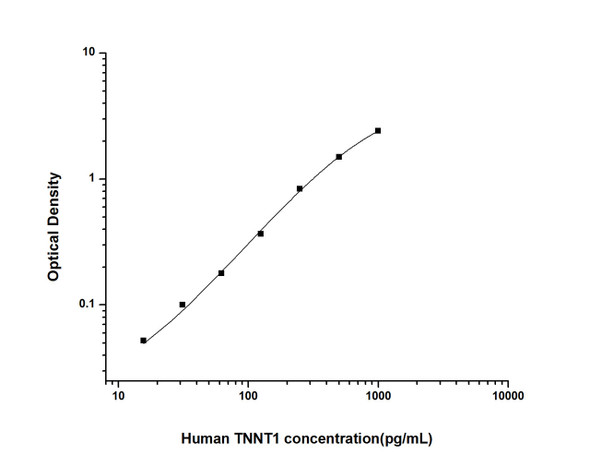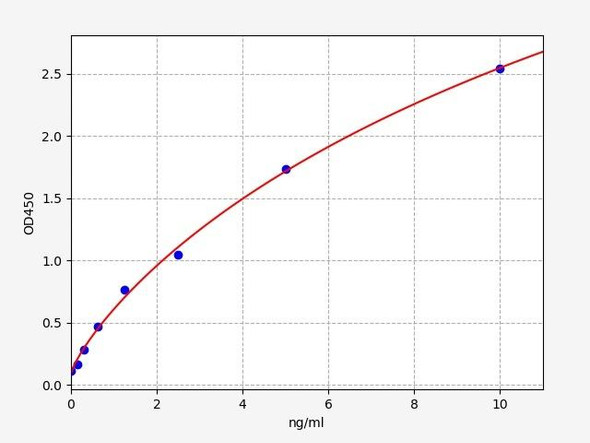Human Cell Biology ELISA Kits 5
Human TNNT1 (Troponin T Type 1, Slow Skeletal) CLIA Kit (HUES00857)
- SKU:
- HUES00857
- Product Type:
- ELISA Kit
- ELISA Type:
- CLIA Kit
- Size:
- 96 Assays
- Sensitivity:
- 4.69pg/mL
- Range:
- 7.81-500pg/mL
- ELISA Type:
- Sandwich
- Reactivity:
- Human
- Sample Type:
- Serum, plasma and other biological fluids
- Research Area:
- Cell Biology
Description
| Assay type: | Sandwich |
| Format: | 96T |
| Assay time: | 4.5h |
| Reactivity: | Human |
| Detection method: | Chemiluminescence |
| Detection range: | 7.81-500 pg/mL |
| Sensitivity: | 4.69 pg/mL |
| Sample volume: | 100µL |
| Sample type: | Serum, plasma and other biological fluids |
| Repeatability: | CV < 15% |
| Specificity: | This kit recognizes Human TNNT1 in samples. No significant cross-reactivity or interference between Human TNNT1 and analogues was observed. |
This kit uses Sandwich-CLIA as the method. The micro CLIA plate provided in this kit has been pre-coated with an antibody specific to Human TNNT1. Standards or samples are added to the appropriate micro CLIA plate wells and combined with the specific antibody. Then a biotinylated detection antibody specific for Human TNNT1 and Avidin-Horseradish Peroxidase (HRP) conjugate are added to each micro plate well successively and incubated. Free components are washed away. The substrate solution is added to each well. Only those wells that contain Human TNNT1, biotinylated detection antibody and Avidin-HRP conjugate will appear fluorescence. The Relative light unit (RLU) value is measured spectrophotometrically by the Chemiluminescence immunoassay analyzer. The RLU value is positively associated with the concentration of Human TNNT1. The concentration of Human TNNT1 in the samples can be calculated by comparing the RLU of the samples to the standard curve.
| UniProt Protein Function: | TNNT1: Troponin T is the tropomyosin-binding subunit of troponin, the thin filament regulatory complex which confers calcium-sensitivity to striated muscle actomyosin ATPase activity. Defects in TNNT1 are the cause of nemaline myopathy type 5 (NEM5); also known as Amish nemaline myopathy (ANM). A form of nemaline myopathy. Nemaline myopathies are muscular disorders characterized by muscle weakness of varying severity and onset, and abnormal thread-or rod-like structures in muscle fibers on histologic examination. Nemaline myopathy type 5 is a severe and progressive form common among Old Order Amish. Affected infants display tremors with hypotonia and mild contractures of the shoulders and hips. Proximal contractures progressively weaken and a pectus carinatum deformity develops before children die of respiratory insufficiency, usually in the second year. Belongs to the troponin T family. 3 isoforms of the human protein are produced by alternative splicing. |
| UniProt Protein Details: | Protein type:Motility/polarity/chemotaxis; Contractile Chromosomal Location of Human Ortholog: 19q13. 4 Cellular Component: cytosol; troponin complex Molecular Function:protein binding; tropomyosin binding; troponin T binding Biological Process: muscle filament sliding; negative regulation of muscle contraction; skeletal muscle contraction; slow-twitch skeletal muscle fiber contraction; transition between fast and slow fiber Disease: Nemaline Myopathy 5 |
| NCBI Summary: | This gene encodes a protein that is a subunit of troponin, which is a regulatory complex located on the thin filament of the sarcomere. This complex regulates striated muscle contraction in response to fluctuations in intracellular calcium concentration. This complex is composed of three subunits: troponin C, which binds calcium, troponin T, which binds tropomyosin, and troponin I, which is an inhibitory subunit. This protein is the slow skeletal troponin T subunit. Mutations in this gene cause nemaline myopathy type 5, also known as Amish nemaline myopathy, a neuromuscular disorder characterized by muscle weakness and rod-shaped, or nemaline, inclusions in skeletal muscle fibers which affects infants, resulting in death due to respiratory insufficiency, usually in the second year. Multiple transcript variants encoding different isoforms have been found for this gene. [provided by RefSeq, Jul 2008] |
| UniProt Code: | P13805 |
| NCBI GenInfo Identifier: | 1174800 |
| NCBI Gene ID: | 7138 |
| NCBI Accession: | P13805. 4 |
| UniProt Secondary Accession: | P13805,O95472, Q16061, Q5U0E1, |
| UniProt Related Accession: | P13805 |
| Molecular Weight: | 31,242 Da |
| NCBI Full Name: | Troponin T, slow skeletal muscle |
| NCBI Synonym Full Names: | troponin T1, slow skeletal type |
| NCBI Official Symbol: | TNNT1 |
| NCBI Official Synonym Symbols: | ANM; TNT; NEM5; STNT; TNTS |
| NCBI Protein Information: | troponin T, slow skeletal muscle |
| UniProt Protein Name: | Troponin T, slow skeletal muscle |
| UniProt Synonym Protein Names: | Slow skeletal muscle troponin T; sTnT |
| Protein Family: | Troponin |
| UniProt Gene Name: | TNNT1 |
| UniProt Entry Name: | TNNT1_HUMAN |
As the RLU values of the standard curve may vary according to the conditions of the actual assay performance (e. g. operator, pipetting technique, washing technique or temperature effects), the operator should establish a standard curve for each test. Typical standard curve and data is provided below for reference only.
| Concentration (pg/mL) | RLU | Average | Corrected |
| 500 | 46635 56439 | 51537 | 51508 |
| 250 | 19099 22897 | 20998 | 20969 |
| 125 | 9632 9160 | 9396 | 9367 |
| 62.5 | 4303 4721 | 4512 | 4483 |
| 31.25 | 2349 2249 | 2299 | 2270 |
| 15.63 | 1279 1221 | 1250 | 1221 |
| 7.81 | 719 761 | 740 | 711 |
| 0 | 28 30 | 29 | -- |
Precision
Intra-assay Precision (Precision within an assay): 3 samples with low, mid range and high level Human TNNT1 were tested 20 times on one plate, respectively.
Inter-assay Precision (Precision between assays): 3 samples with low, mid range and high level Human TNNT1 were tested on 3 different plates, 20 replicates in each plate.
| Intra-assay Precision | Inter-assay Precision | |||||
| Sample | 1 | 2 | 3 | 1 | 2 | 3 |
| n | 20 | 20 | 20 | 20 | 20 | 20 |
| Mean (pg/mL) | 27.60 | 53.79 | 166.94 | 28.19 | 50.86 | 174.29 |
| Standard deviation | 3.07 | 3.79 | 12.89 | 3.33 | 4.87 | 15.22 |
| C V (%) | 11.12 | 7.05 | 7.72 | 11.81 | 9.58 | 8.73 |
Recovery
The recovery of Human TNNT1 spiked at three different levels in samples throughout the range of the assay was evaluated in various matrices.
| Sample Type | Range (%) | Average Recovery (%) |
| Serum (n=5) | 90-103 | 96 |
| EDTA plasma (n=5) | 99-116 | 106 |
| Cell culture media (n=5) | 89-100 | 94 |
Linearity
Samples were spiked with high concentrations of Human TNNT1 and diluted with Reference Standard & Sample Diluent to produce samples with values within the range of the assay.
| Serum (n=5) | EDTA plasma (n=5) | Cell culture media (n=5) | ||
| 1:2 | Range (%) | 99-114 | 98-109 | 93-108 |
| Average (%) | 106 | 103 | 100 | |
| 1:4 | Range (%) | 86-99 | 87-98 | 96-109 |
| Average (%) | 91 | 93 | 104 | |
| 1:8 | Range (%) | 93-106 | 102-116 | 85-98 |
| Average (%) | 99 | 108 | 91 | |
| 1:16 | Range (%) | 103-115 | 89-101 | 96-112 |
| Average (%) | 109 | 96 | 104 |
An unopened kit can be stored at 4°C for 1 month. If the kit is not used within 1 month, store the items separately according to the following conditions once the kit is received.
| Item | Specifications | Storage |
| Micro CLIA Plate(Dismountable) | 8 wells ×12 strips | -20°C, 6 months |
| Reference Standard | 2 vials | |
| Concentrated Biotinylated Detection Ab (100×) | 1 vial, 120 µL | |
| Concentrated HRP Conjugate (100×) | 1 vial, 120 µL | -20°C(shading light), 6 months |
| Reference Standard & Sample Diluent | 1 vial, 20 mL | 4°C, 6 months |
| Biotinylated Detection Ab Diluent | 1 vial, 14 mL | |
| HRP Conjugate Diluent | 1 vial, 14 mL | |
| Concentrated Wash Buffer (25×) | 1 vial, 30 mL | |
| Substrate Reagent A | 1 vial, 5 mL | 4°C (shading light) |
| Substrate Reagent B | 1 vial, 5 mL | 4°C (shading light) |
| Plate Sealer | 5 pieces | |
| Product Description | 1 copy | |
| Certificate of Analysis | 1 copy |
- Set standard, test sample and control (zero) wells on the pre-coated plate and record theirpositions. It is recommended to measure each standard and sample in duplicate. Note: addall solutions to the bottom of the plate wells while avoiding contact with the well walls. Ensuresolutions do not foam when adding to the wells.
- Aliquot 100µl of standard solutions into the standard wells.
- Add 100µl of Sample / Standard dilution buffer into the control (zero) well.
- Add 100µl of properly diluted sample (serum, plasma, tissue homogenates and otherbiological fluids. ) into test sample wells.
- Cover the plate with the sealer provided in the kit and incubate for 90 min at 37°C.
- Aspirate the liquid from each well, do not wash. Immediately add 100µL of BiotinylatedDetection Ab working solution to each well. Cover the plate with a plate seal and gently mix. Incubate for 1 hour at 37°C.
- Aspirate or decant the solution from the plate and add 350µL of wash buffer to each welland incubate for 1-2 minutes at room temperature. Aspirate the solution from each well andclap the plate on absorbent filter paper to dry. Repeat this process 3 times. Note: a microplatewasher can be used in this step and other wash steps.
- Add 100µL of HRP Conjugate working solution to each well. Cover with a plate seal andincubate for 30 min at 37°C.
- Aspirate or decant the solution from each well. Repeat the wash process for five times asconducted in step 7.
- Add 100µL of Substrate mixture solution to each well. Cover with a new plate seal andincubate for no more than 5 min at 37°C. Protect the plate from light.
- Determine the RLU value of each well immediately.






